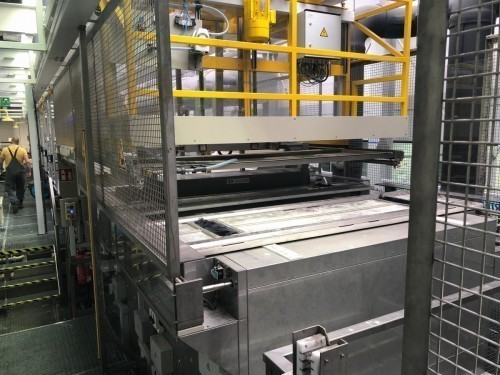Drying bulk materials in line simplifies the process flow. A metal processing company has been using a technology that dries bulk materials directly in the drum for 15 years.
Phoenix Feinbau GmbH & Co KG from Lüdenscheid had already decommissioned its previous centrifuge dryer in 2005 and replaced it with a drum dryer. The company wanted to improve the drying process for the highly sensitive stamped metal parts that are coated in its in-house electroplating shop and finally eliminate the annoying loss of quality caused by centrifuging. The company had heard about the alternative drying technology from Harter, which boasted the ability to dry bulk materials directly in the container. "At the time, it was a retrofit of an existing system. The result was so good that future systems should only be equipped with Harter technology," explains Frank Daube, Group Manager Production Surface Technology.
The whole process has now been continued in a completely new system, which was purchased due to an expansion of the company. The terminal manufacturer, which specializes in toolmaking, stamped part production, surface technology and assembly with injection moulding production, wanted to run higher capacities in the new electroplating facility. And a new Harter dryer had to meet all quality and time requirements. Of course, this included ensuring that the fine special parts, some of which are highly scooping and therefore difficult to dry, are dried homogeneously and completely.
 Each drying station has an automatic lid system that keeps the valuable heat in the system. Drying takes place in an airtight system
Each drying station has an automatic lid system that keeps the valuable heat in the system. Drying takes place in an airtight system
As a rule, the drying system manufacturer Harter designs each drum dryer, and in general each dryer, individually for the respective application. Every manufacturer and every contract electroplater has its own portfolio and its own process to which the dryer must be adapted. Harter usually carries out drying tests with the customer's original parts before planning the system. The parameters relevant for drying are determined in his in-house technical center: Time, humidity, temperature, speed and volume flow of the air and the correct air flow. The customer can also get an idea of the performance of the condensation drying system with heat pump developed by Harter. Reinhold Specht, Managing Partner at Harter, explains: "Quite a few of our drum dryer customers thought it was simply impossible beforehand that we could dry their parts directly in the drum. If you can see it with your own eyes during the tests, the proof is in the pudding." Phoenix Feinbau decided not to carry out drying tests as they already knew about the success of the previous project.
Drums with the finest perforation
The following drying system was designed for Phoenix Feinbau, which is part of the global Phoenix Contact Group: 3 drying stations measuring L x W x H = 2946 x 1450 x 1894 mm and a so-called Airgenex® dehumidification module. As soon as the drum unit has left the last sink, it moves directly into a dryer and remains there for 3 cycles. In this way, 3 drum units are conveyed alternately into the 3 dryers. After the drying time, the drums leave the dryer. At this point, the bulk materials are completely dry. 6 special fans and a corresponding air guidance system are installed in each drum dryer. The fans are speed-controllable. This means that the speed can be programmed according to the items. Thanks to the correct air flow, all parts are dried evenly. During drying, the drums are carefully rotated at intervals of 10 seconds per minute. This process supports the drying process. The rotation is slow so that the parts are not damaged in any way. The rotation intervals can also be set according to the item. The drying temperature at Phoenix is 70 °C. The drums have a length of 1470 mm and a diameter of 500 mm. Their perforations are between 0.25 mm and 2 mm.
Drying without exhaust air
Connected to the 3 dryers is a dehumidification module, which prepares the required process air and is therefore the heart of every drying system. The air is dehumidified and heated here. This unsaturated air is then fed onto or, in the case of drum drying, over and through the products to be dried. For physical reasons, it absorbs the moisture very quickly. Back in the dehumidification module, the air is cooled and the water condenses out. The process air is reheated and fed back into the dryer. It is important here that the circuit is closed. This closed-air system with its integrated heat pump technology enables energy-efficient andCO2-saving drying. The condensation drying system with heat pump developed by Harter is also the only system on the market that works completely without exhaust air. The production halls and, above all, the employees remain completely unpolluted.
Economical in terms ofCO2 and energy
All components must be evenly dehumidified. To achieve this goal, the air flow must be evenly distributed throughout the entire drum. "We have developed a special technology within the drum dryer for drying in drums. This is the only way to guarantee that the dry air actually flows through the drum and out of it again," says Specht about his expertise, which he does not want to explain in detail.
The Harter dryers are also very interesting from an energy point of view. The integrated heat pump technology is extremely energy- andCO2-saving and is therefore subsidized by the state. At Phoenix, the nominal output of the drying system in production mode is approx. 38 kW. That is around 70% less than a conventional hot-air oven normally requires. "For us, the connection to Harter and its technology has been crowned with complete success," concludes Daube.


